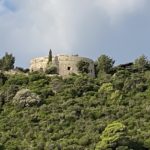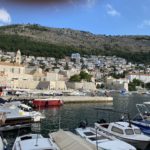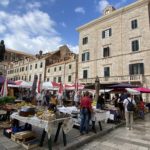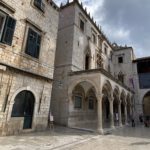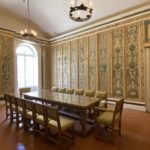 We were at anchor overnight at Slona Bay. While we had breakfast, the captain raised the anchor and set off for the Old Town of Dubrovnik. We were treated to a waterside view of Dubrovnik’s wall, familiar to many from Game of Thrones. The Old Port is a well sheltered harbor used today by small boats and tourist boats. Our tender from La Perla dropped us there. We met Paolo, our guide, for a walking tour of Old Town. Our first stop was the Arsenal, which we had discovered on this trip was not a munitions storage, but was a dry dock for building ships. Dubrovnik’s shipbuilders were so skilled that spies would try to appropriate their techniques, so to combat that theft the arches were walled up as construction began and were not exposed until the ships were launched. Dubrovnik was not founded by the Greeks or Romans but was founded in the 7th century by fugitives a nearby town. It came under Byzantine and Venetian rule, but finally gained its independence in 1382 when it became the Republic of Ragusa. It flourished from the trade routes that criss crossed the Adriatic to become a great maritime republic. It was devastated by an earthquake in 1667; the Old Town was largely rebuilt afterwards. In 1991 and 1992 it was the target of heavy bombing by Yugoslav troops. But, Dubrovnik has rebounded and attracts visitors and filmmakers alike. Most know that much of Game of Thrones was filmed here. The walls date to the 10th century and offer stunning views from the guards’ walkway. They contain a total of 776 steps. In the 13th century they were modified to make them thicker, a stronger fortification. The walls are 6,363 feet long and at their highest are 82 feet. Those facing inland are 20 feet wide. Visitors walk anti clockwise around the walls.
We were at anchor overnight at Slona Bay. While we had breakfast, the captain raised the anchor and set off for the Old Town of Dubrovnik. We were treated to a waterside view of Dubrovnik’s wall, familiar to many from Game of Thrones. The Old Port is a well sheltered harbor used today by small boats and tourist boats. Our tender from La Perla dropped us there. We met Paolo, our guide, for a walking tour of Old Town. Our first stop was the Arsenal, which we had discovered on this trip was not a munitions storage, but was a dry dock for building ships. Dubrovnik’s shipbuilders were so skilled that spies would try to appropriate their techniques, so to combat that theft the arches were walled up as construction began and were not exposed until the ships were launched. Dubrovnik was not founded by the Greeks or Romans but was founded in the 7th century by fugitives a nearby town. It came under Byzantine and Venetian rule, but finally gained its independence in 1382 when it became the Republic of Ragusa. It flourished from the trade routes that criss crossed the Adriatic to become a great maritime republic. It was devastated by an earthquake in 1667; the Old Town was largely rebuilt afterwards. In 1991 and 1992 it was the target of heavy bombing by Yugoslav troops. But, Dubrovnik has rebounded and attracts visitors and filmmakers alike. Most know that much of Game of Thrones was filmed here. The walls date to the 10th century and offer stunning views from the guards’ walkway. They contain a total of 776 steps. In the 13th century they were modified to make them thicker, a stronger fortification. The walls are 6,363 feet long and at their highest are 82 feet. Those facing inland are 20 feet wide. Visitors walk anti clockwise around the walls.
Paolo gave us insight into Dubrovnik’s early government and polices that seemed progressive for the time as we walked the Loggis square, the political and economic center at the east end of the Stradum surrounded by important buildings. Today it is still a popular meeting place. Orlando’s Column, built by sculptor Antonio Ragusino in 1418 was being restored or renovated while we were there. The Church of St Blaise was rebuilt in early 18th century according to a 17th century design. St Blaise is the patron saint of Dubrovnik, but may actually be a fictional character. There are statues of St Blaise everywhere. Not far away, the Cathedral was built after the earthquake in 1667 and the Cathedral Treasury houses reliquaries and sacred objects. The nearby Rector’s Palace was the seat of the most important government institutions. It housed the Upper and Lower Council as well as the rector’s Quarters. It was built in the 15th century on the site of a medieval fortress. It now houses the Cultural Historical Museum with items from the 16th to 20th centuries. Next door is the 1863 Town Hall, home to a cafe and a theater.
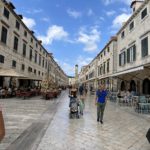 We strolled by the daily street market and then walked the Stradun or wide main street that runs east to west and follows the line that separated the island from the mainland. Just off the Stradun, we found the old Jewish Quarter. Then we continued down towards the Pile Gate, the main city gate with another statue of St Blaise. Nearby was the Big Fountain of Onofrio, built in 1438 by Onofrio de la Cava, who designed the City’s water system. Water from the fountain is very drinkable.
We strolled by the daily street market and then walked the Stradun or wide main street that runs east to west and follows the line that separated the island from the mainland. Just off the Stradun, we found the old Jewish Quarter. Then we continued down towards the Pile Gate, the main city gate with another statue of St Blaise. Nearby was the Big Fountain of Onofrio, built in 1438 by Onofrio de la Cava, who designed the City’s water system. Water from the fountain is very drinkable.
We entered the small Church of St Saviour, where we were treated to a private concert by a classical quartet (Kvartet Sorkocevic: consisting of Dive Kuselj on the flute, Slobodan Begic on the violin, Denis Ajdukovic on bass, and Nina Corak on the piano). They played: L Sorkocevic’s Symphony No 1 D Major Allegro, T. Albinoni’s Adagio, Mozart’s Overture Figaro’ Hochzeit, V Billi’s Fantasia Tripolina, F Drdla’s Serenade, Ch Gounod’s Ave Maria, and G Rossini’s Overture Italian Girl in Algeria.
Afterwards we visited the Franciscan Monastery, whose construction began in 1317 and finally completed the following century. It was mostly rebuilt after the earthquake but the 15th century cloister escaped damage. The third oldest pharmacy in use since 1317 is located within its walls.
We lunched at Oliva in town and skipped lunch aboard La Perla. As we dined we saw Stefan and his son, Luka. Luka is just like his Dad, outgoing and gregarious saying CHOW to everyone. Stefan told him it was Mike’s Birthday and he sang Happy Birthday in Croatian. Then we spent time in the Rector’s Palace. We headed back to the Old Harbor to catch the tender back to La Perla and met Stefan’s wife. La Perla was moving at 2:45 PM to the new harbor in the Bay of Gruz so we could tie up to the dock. We ended up rafting up (being the fourth boat from the dock!) At 5 PM, the Covid testing folks came aboard and tested those of us leaving for home on Sunday.
At 6 PM we walked through the three boats closest to the dock, disembarked, and took a bus driven by Bruno through winding narrow roads to Gromaca, a small village of about 100 people (80 of whom are related) where we divided into three groups and were hosted for a family dinner at a regular household by Tereza and her niece Anna. We were greeted with a grappa
with herbs or rose petal brandy, fresh figs, orange peel candy,
and grapes – all made/grown by Tereza. Anna showed us their smoke house and garden, then invited us in for dinner. We had vegetable soup, Tereza’s red wine, homemade bread, Tereza’s olive oil, stuffed peppers, mashed potatoes, and a dessert of rozata (Croatian flan or creme
caramel custard). All the while, Anna answered our questions about daily life in this part of Croatia.









